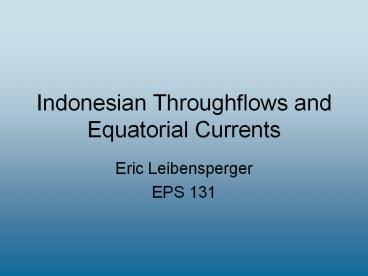Indonesian Throughflows and Equatorial Currents - PowerPoint PPT Presentation
1 / 13
Title:
Indonesian Throughflows and Equatorial Currents
Description:
System of surface currents flowing from the Pacific Ocean to ... Philander, S.G.H. (1980), The Equatorial Undercurrent Revisited. Ann. Rev. Earth Planet Sci. ... – PowerPoint PPT presentation
Number of Views:115
Avg rating:3.0/5.0
Title: Indonesian Throughflows and Equatorial Currents
1
Indonesian Throughflows and Equatorial Currents
- Eric Leibensperger
- EPS 131
2
Indonesian Throughflow
- System of surface currents flowing from the
Pacific Ocean to the Indian Ocean through the
Indonesian Seas. - Important because it is the only low latitude
transport between oceans - Even more important because one of the oceans is
the warm Western Pacific
3
Importance of ITF
- Connection of warm Pacific waters to the cooler
waters of Indian Ocean. - Large part of E-W transport of heat in climate
system - Transports 12 Sv of warm, low salinity water
4
Why study ITF?
- Transport can vary up to 100 seasonally and
annually. - Transfer of heat affects the rain (or lack of
rain) and fire seasons of Northwest Australia and
Southeast Asia, thus is a large environmental and
economic factor.
- Without ITF, region would be colder and drier.
- Area of large air-sea interaction (because it is
so warm).
5
Why so warm?
- The equatorial region in the western Pacific is
very warm. Below The warmer waters of the
western Pacific reach deeper than the eastern
Pacific. With diverging Ekman transport at the
equator, upwelling brings up warm water in the
west and cooler water in the east.
6
Why so warm? Contd
Result of Indonesian Throughflow!!
- Warm water increases evaporation, which increases
heat released from condensation in the atmosphere
and rainfall. The fluctuations of the ITF affect
the ocean, land and atmosphere.
7
A Very Grainy Movie, but
8
Equatorial Currents
North Equatorial Current 20 cm/sec, 200m deep
North Equatorial Countercurrent Between 3-10N,
50 cm/sec, centered around tropical convergence
zone (where N-S trade winds converge), 20Sv
South Equatorial Current Max of 100 cm/sec, 200m
deep
9
North Equatorial Countercurrent
- Responsible for eastern heat flow.
- In Pacific, on the eastern edge (diverges) into
two currents, the northern divergence supplies
the California countercurrent. - Intensifies during El Nino events.
10
Equatorial Undercurrents
- First noticed in 1950s by a United States Fish
and Wildlife team fishing for tuna south of
Hawaii.
11
More on Undercurrents
- Surface flows west, but starting between 20-40m
the undercurrent is towards the east. - Extends to 400m and can transport up to 30 Sv.
- Symmetrical about equator, dying off by 2ºN and
S. - Max velocities of 1.5 m/sec.
- Explanation still not fully understood, but
thought to be a result of the conservation of
potential vorticity.
12
Tying it all together
13
References
- CSIRO Marine Research, Indonesian Throughflow
Facts, http//www.marine.csiro.au/LeafletsFolder/p
dfsheets/64indothroughflow.pdf - Fundamentals of Physical Geography,
http//www.physicalgeography.net - Introduction to the Indian Ocean,
http//indianocean.free.fr/intro.html - Philander, S.G.H. (1980), The Equatorial
Undercurrent Revisited. Ann. Rev. Earth Planet
Sci., 8, 191-204. - Stewart, R.(2005). Introduction to Physical
Oceanography, http//oceanworld.tamu.edu/resources
/ocng_textboo k/contents.html

